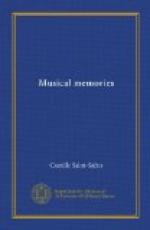One day I was walking in a garden. There was a bandstand and musicians were playing some sort of music. The crowd was indifferent and passed by talking without paying the slightest attention. Suddenly there sounded the first notes of the delightful andante of Beethoven’s Symphony in D—a flower of spring with a delicate perfume. At the first notes all walking and talking stopped. And the crowd stood motionless and in an almost religious silence as it listened to the marvel. When the piece was over, I went out of the garden, and near the entrance I heard one of the managers say,
“There, you see they don’t like that kind of music.
And that kind of music was never played there again.
CHAPTER IX
ANARCHY IN MUSIC
Music is as old as human nature. We can get some idea of what it was at first from the music of savage tribes. There were a few notes and rudimentary melodies with blows struck in cadence as an accompaniment; or, sometimes, the same primitive rhythms without any accompaniment—and nothing else! Then melody was perfected and the rhythms became more complicated. Later came Greek music, of which we know little, and the music of the East and Far East.
Music, as we now understand the term, began with the attempts at harmony in the Middle Ages. These attempts were labored and difficult, and the uncertainty of their gropings, combined with the slowness of their development, excites our wonder. Centuries were necessary before the writing of music became exact, but, slowly, laws were elaborated. Thanks to them the works of the Sixteenth Century came into being, in all their admirable purity and learned polyphony. Hard and inflexible laws engendered an art analogous to primitive painting. Melody was almost entirely absent and was relegated to dance tunes and popular songs. But the dance tunes of the time, on which, perhaps, erudition was not used sufficiently, were written in the same polyphonic style and with the same rigid correctness as the madrigals and the church music.
We know that the popular songs found their way into the church music and that Palestrina’s great reform consisted in banishing them. However, we should get but a feeble idea of the part they played, if we imagined that they naturally belonged there. Take a well known air, Au Claire de la Lune, for example, and make each note a whole note sung by the tenor, while the other voices dialogue back and forth in counterpoint, and see what is left of the song for the listener. The scandal of La Messe de l’Homme arme was entirely theoretical.




